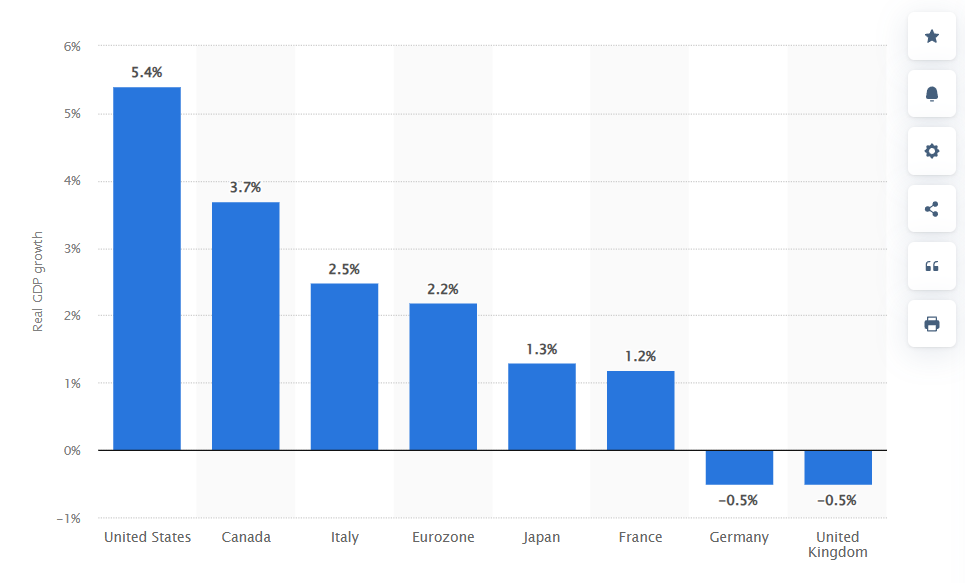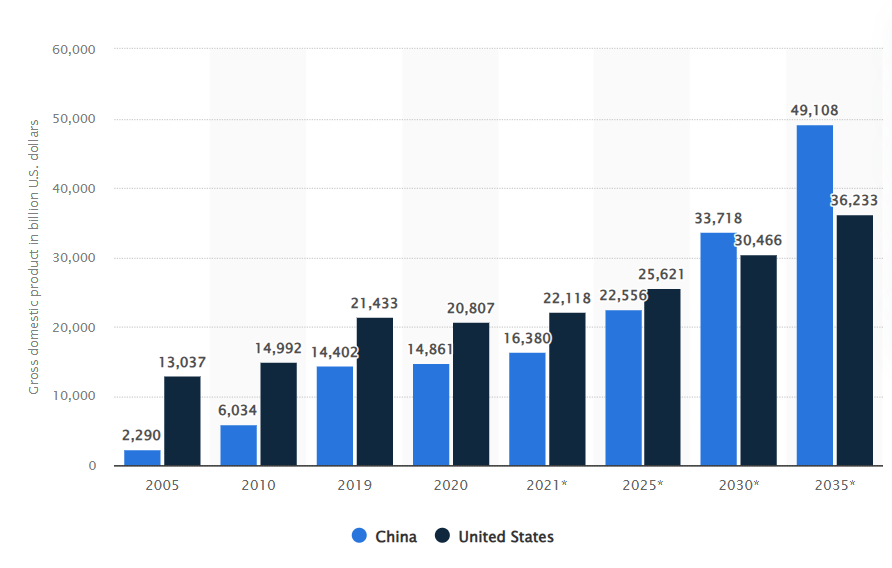And now comes Investopedia. Perhaps you will wish to reevaluate any positive thoughts you may have had for this “pedia” regarding federal financing. Here is why:
This Measure of National Debt is Highest Since World War II, Study Shows By Terry Lane Published June 26, 2024 02:34 PM EDT
1. U.S. debt-to-GDP ratio is the fourth largest among a group of nearly 40 developed economies, according to the Organization for Economic Co-operation and Development (OECD).
Last year, the country’s debt-to-GDP ratio was the highest since World War II as spending designed to help Americans recover from the pandemic added to debt levels.
OECD said there is still room for the U.S. to narrow the gap between how much money it brings in and how much money it spends (i.e. reduce the debt).
U.S. national debt relative to its economic output is now among the highest for developed countries even as the economy chugs along, a report by an international economic agency showed.
See those six little words, “even as the economy chugs along.” Revise that phrase to: “which is why the economy chugs along,” because so-called “federal debt” (that isn’t federal and isn’t debt) adds growth dollars to the economy.
More federal debt adds more growth dollars, and less federal debt leads to recessions and depressions.

This cause-effect relationship is so powerful, that when there is a decrease in the debt itself (i.e. a surplus) we usually have depressions.
Every U.S. depression has come on the heels of federal surpluses.
1804-1812: U. S. Federal Debt reduced 48%. Depression began 1807.
1817-1821: U. S. Federal Debt reduced 29%. Depression began 1819.
1823-1836: U. S. Federal Debt reduced 99%. Depression began 1837.
1852-1857: U. S. Federal Debt reduced 59%. Depression began 1857.
1867-1873: U. S. Federal Debt reduced 27%. Depression began 1873.
1880-1893: U. S. Federal Debt reduced 57%. Depression began 1893.
1920-1930: U. S. Federal Debt reduced 36%. Depression began 1929.
1997-2001: U. S. Federal Debt reduced 15%. Recession began 2001.The article continues:
The Organization for Economic Co-operation and Development (OECD) warned U.S. debt increased to 122% the size of its gross domestic product (GDP) last year. The debt-to-GDP ratio is an often-used metric to gauge a country’s ability to repay what it owes.
The debt/ratio shows nothing of the kind. It is a useless, misinforming, number
For a Monetarily Sovereign government that ratio does not indicate anything about a nation’s ability or willingness to pay its creditors. (It does have some meaning for monetarily non-sovereign governments, because they rely on income to fund spending. Monetarily Sovereign governments do not.)
The U.S. national debt has grown in the wake of the COVID-19 pandemic as policymakers voted to spend money to help stimulate the economy during that time.
The U.S. debt-to-GDP ratio is at its highest since World War II and is the fourth largest—behind only Japan, Greece and Italy—among the 38 OECD member states.
Unlike its peers, U.S. debt ratio has not returned to its pre-pandemic levels, the OECD found.
Federal deficit spending stimulates the economy. The article’s author, Terry Lane, wishes to reduce economic growth, seemingly because he doesn’t like the words “federal debt.” (?)
Never mind that the U.S. federal government has the infinite ability to create dollars and to pay for anything without collecting a penny in taxes. It’s just that darn phrase, “federal debt,” that, by the way, isn’t federal and isn’t debt.
It’s not “federal” because the contents of the T-security accounts upon which it is based are wholly owned by depositors. The federal government never uses that money. Those accounts resemble bank safe deposit boxes. The money in T-security accounts merely is held for safekeeping, not used to fund spending.
It isn’t debt because all federal deficit spending has already been paid for. No one owes the “federal debt,” not the government or taxpayers. For the same reasons, it also isn’t “borrowing,” a word often misused to describe T-securities.
Depositors are not lenders. The federal government could continue to pay all its bills, even if not on T-security was issued.
In summary:
- The U.S. fiscal stimulus was large compared to most other countries.
- Domestic spending rebounded faster than GDP, driven by demand for imported goods.
- The trade deficit grew as imports surged and exports contracted; the dollar outflow made federal deficit spending even more critical.


China’s debt-to-GDP ratio was 288% in 2023. The consequence of that high ratio is that China’s economy is projected to pass America’s as the world’s largest economy. Deficit spending stimulates economic growth. The lack of deficit spending creates recessions and depressions, which must be cured by increased deficit spending.

The author continues:
There Is Opportunity to Lessen US Debt
That “opportunity” to lessen the debt also is an “opportunity” to send America into a depression.
At the same time, the group’s 2024 Economic Survey of the United States showed consumer spending, a strong labor market and eventual interest rate cuts should all help to keep the U.S. economy moving forward, albeit at a slower pace.
The OECD projected U.S. gross domestic product (GDP) to increase slightly in 2024 to 2.6%, before slowing to 1.8% in 2025.
Considering this formula: GDP = Federal Spending + Non-federal Spending + Net Exports, it’s quite amazing that the OECD can predict GDP without knowing any of the three right-hand terms of the equation. In economics, the technical term for that is a WAG (Wild Ass Guess).
Federal Spending also affects the other two terms. It’s like a football pundit who recommends fewer runs, passes, and kicks, then with no idea about any of the three, predicts football game scores.
“This strong recovery creates a good opportunity to start narrowing the budget deficit and put debt on a more prudent path,” said OECD Secretary-General Mathias Cormann, who urged the U.S. to enact a series of spending cuts and tax hikes in 2025 to begin pruning the budget deficit.
Translation: Increased budget deficits are necessary to increase economic growth, so cutting budget deficits is prudent.
The report noted the U.S. should consider making changes in its budgeting process, including eliminating the “debt ceiling” that has led to political standoffs.
Huh? First, they complain about the debt/GDP ratio; then, they (correctly) complain about the “debt ceiling,” which limits the government’s ability to grow the debt/GDP ratio.
It’s like complaining about weight-loss efforts and then complaining about being overweight.
“Replacing the debt ceiling with a simple medium-term debt ratio target would be simpler than existing legislative budget rules and would provide more clarity for public budgeting,” the report said.
Perfect. The author has adopted the worst of all worlds. He wants a debt/GDP limit, not a debt limit (Huh?, again). Why? “For clarity.”
To the people at Investopedia and its peers: Look at historical data rather than following intuition. There is a difference between Monetarily Sovereign debt and monetarily non-sovereign debt. Don’t just parrot popular misinformation.
SUMMARY
Every ounce of historical evidence demonstrates:
- The federal government never can run short of dollars.
- So, it never needs to borrow dollars.
- What is commonly called “federal debt” is really deposits into accounts, the purposes of which are to provide dollar users with a safer place than private banks, to store unused dollars, and to help the Fed control interest rates.
Federal “bills,” “notes,” and “bonds” are not related to private sector bills, notes, and bonds.
Thus, the debt/GDP ratio is a meaningless fraction for a Monetarily Sovereign government (though it does have significance for monetarily non-sovereign entities). It tells nothing about the federal government’s infinite ability to pay its obligations or about any taxpayer obligations (zero).
Rodger Malcolm Mitchell Monetary Sovereignty Twitter: @rodgermitchell Search #monetarysovereignty Facebook: Rodger Malcolm Mitchell; MUCK RACK: https://muckrack.com/rodger-malcolm-mitchell……………………………………………………………………..
The Sole Purpose of Government Is to Improve and Protect the Lives of the People.
MONETARY SOVEREIGNTY
The words “federal debt” seems to me to be a scare tactic aimed at the Democratic Party, making them sound like they spend too freely, and making the Republican Party sound like they are the only ones concerned about fiscal responsibility. I appreciate how hard you are trying to show people the truth. But I think there is a disconnect.
If you don’t mind my saying, you don’t speak “everyman” language. You need someone to translate your words to direct them to 5th Graders. The majority of American voters (voters anywhere, to be honest) are scared of figures reaching into the billions or trillions of dollars. They cannot conceive of such astronomical amounts of money, so they shut down and stop listening.
They can barely run their own family finances; you cannot expect the may of them to listen to you. After reading your posts for over a year now, this is what I am seeing. No insult intended.
Why federal tax dollars are destroyed.
LikeLike
I know what you mean. It could be on purpose that economics is so confusing. It keeps the average person at bay, out of the way, and feeling inferior. The know-it-alls are allowed to continue their stupid sleight of hand only to make matters all the worse. Roger does about as good a job as he can to open our eyes to this huge joke of ill-defined wealth and scarcity being perpetrated on the world.
LikeLike
Certainly on America. Certainly on Canada! I don’t know enough about monetary sovereignty and other nations, but one can expect them to be quite similar. Any nations with voters should be better informed. Maybe then the Populists would not hold sway.
LikeLike
Something I noticed about people, when they’re proven wrong, is they go silent rather than try to argue. They know it’s over so, tail between their legs, they clam up and walk away. In the same way, I get the feeling monetary sovereignty can cause big-shot economists (Austan Goolsbee) to clam up or pretend not to know anything about MS, i.e. willful ignorance. It’s this type of reaction that tells me they know MS is doable but refuse to admit it, unfortunately.
LikeLike
Or, they say I’m full of sh*t and walk away.
LikeLiked by 1 person
Not surprised there!
LikeLike